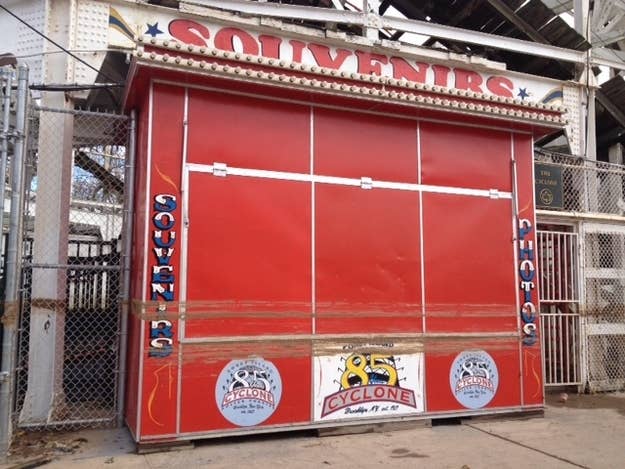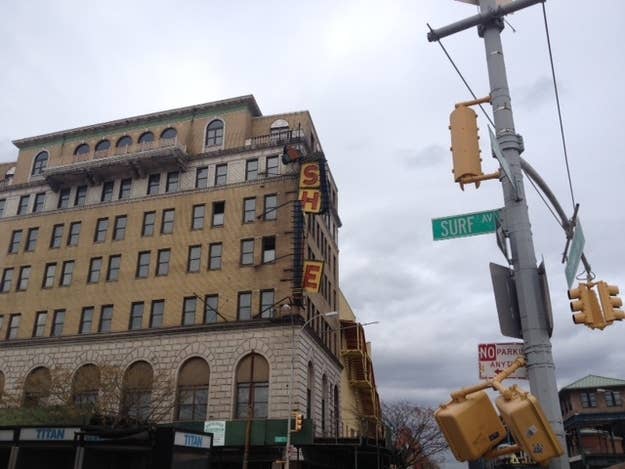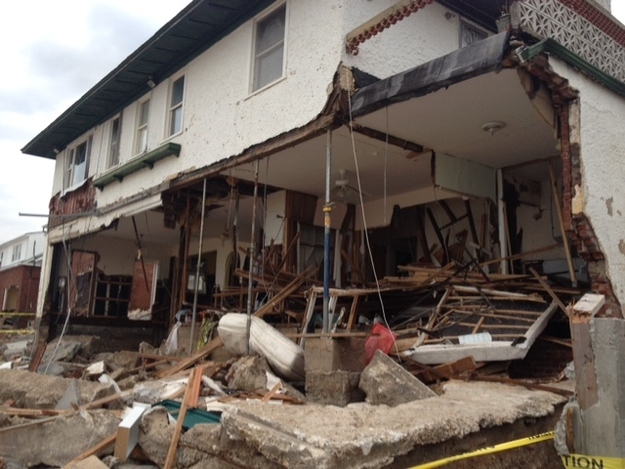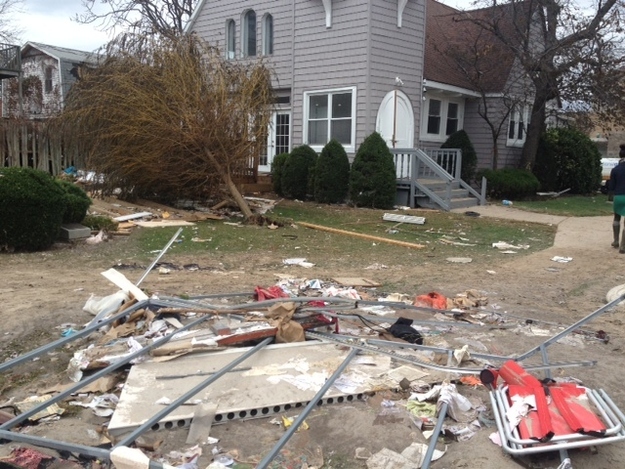
CONEY ISLAND, NY — The feeling that something is very wrong on Coney Island sets in somewhere before Brighton Beach, the heavily Russian neighborhood in southeast Brooklyn. No traffic lights were working on Wednesday in that area. The few open storefronts were occupied by beleaguered-looking people tried to sweep water out of their businesses.
On the boardwalk that stretches from Brighton Beach to Coney Island, barely any of the boards are visible anymore, replaced by a thick layer of sand brought in by Hurricane Sandy. People in groups of one or two wander the boardwalk slowly, taking pictures of the destruction at places like Tatiana Restaurant, where the awning has completely come off. Its owners were spraying it down with water on Wednesday, trying to remove all the sand.
The mood grows grimmer on the way to Coney Island, where the waterline on the businesses next to the boardwalk is at least four feet high and the famous amusement park is shuttered. The New York Aquarium’s parking lot is covered with slick, greasy mud, and workers there were so harried on Wednesday that they couldn’t talk at all. Coney Island had no electricity as of Wednesday afternoon. Residents in Coney say they have friends who no longer have access to food or shelter as a result of the storm, there have been reports of looting, and the Sea Gate community was almost demolished.
Coney Island, a century-old tourist attraction that had changed scarcely at all in its raw, unreflective spirit little since “Little Runaway” helped make it an icon in 1952, is a grim place on a good day almost as soon as you step off the boardwalk. The neighborhood has high crime rates and poverty, a fact hidden to those who come to enjoy the Cyclone roller coaster in the summer. But Sandy has erased whatever lighthearted atmosphere Coney can convey.

“People over here and on West 60th Street, there are a lot of bungalows where people are living sublevel, and they literally escaped with their lives,” said Barry Flynn, one of the managers of Coney Cones, an ice cream shop on the boardwalk.
The problem, Flynn said, was “mostly the electricity, but also the massive flooding.” Even on Surf Avenue, a block from the boardwalk, the waterline came up multiple feet on the row of closed businesses.
“Then there’s these gangsters that are robbing people,” Flynn said. He had been riding his bike to survey the damage on the boardwalk. Reports of looting on Coney Island have been coming in since yesterday; the New York Daily News reported that one witness estimated that a mob of 50 to 100 people were involved.
Flynn said he had a friend who had called him in tears, saying that since all the ATMs were out because of the power loss, she was out of money. She “has no way to get food,” Flynn said.
“It’s really hard,” Flynn said. “People are just numbed.”
Abdullah, an immigrant from the former Yugoslavia, stood on the boardwalk near his bike, feeding pigeons with bread that he chewed before scattering for the birds.
“The storm is no good for America,” he said. “Every day I come here. I’ve been here for 10 years, but people 20, 30 years before, they say they’ve never seen this. Never.”
But he said he had faith the businesses on Coney Island would bounce back. “It’s America.”

City Council Speaker Christine Quinn was in the area on Wednesday, visiting the destroyed neighborhood of Sea Gate and giving an interview to NY1 on the sidewalk.
She told a small gaggle of reporters that “anyone who is caught looting in this storm should have the book thrown at them in a way that is extreme. I would quite frankly say, you know, don’t even give them bail. Make them sit inside until the storm is totally gone and the power outage is over — that’ll teach you a lesson next time the power goes out.” Quinn said that water and food delivery would be prioritized for the emergency shelters, then to the neighborhoods that
need them.
Domenic Recchia, the councilman for the district, added that the city had sent 150 extra police officers to the area.
Still, a feeling of lawlessness pervades Coney, even in daylight. There are plenty of police and other city personnel, but the lack of lights, the desolation, and the gray skies left over from Sandy — all set against the carnival rides, minor league ballpark, and deserted boardwalk — made the atmosphere overwhelmingly tense.

And a mile-long drive down Surf Avenue reveals a disaster zone. Sea Gate, a well-heeled gated community with a large Orthodox and Hasidic Jewish population, has been all but destroyed after Sandy.
Unlike Breezy Point, in Queens, the neighborhood was unaffected by fire. But the orderly rows of houses, especially those next to the beach, were ravaged by the waves. Some houses completely collapsed. Others lost the whole back of the building, leaving a gaping hole and wreckage where the side of the home once was — one family in this situation could be seen picking through the remains of their living room, which was bared open to the world. The house looked like it had been hit with a bomb. Pink linoleum from the kitchen lay in pieces on the sand. The streets are a mix of mud and sand, uneven and gritty like badly maintained roads in the developing world. On one corner, a waterlogged copy of the Talmud lay on the ground.
“It really just looks worse than you could have imagined,” Quinn said of Sea Gate. “Houses completely washed away, fronts of houses torn off, cars piled on top of each other like they’re matchbooks — just terrible.”
Most of Sea Gate seems to have left by now, but on Wednesday, the community still had a large police presence as well as representatives from other city institutions, like the Department of Buildings. Gawkers from greater Coney Island came through to take pictures, and some residents had returned to pack up their belongings.

Devorah Steinberger, 64, stood next to the beach with her hands raised in the air, praying to God, she said. Originally from Israel, she has lived in Sea Gate for 35 years. Her house survived, though the storm flooded her basement and the first floor.
“When the wave came, it even took the garbage can from the kitchen into the basement,” Steinberger said. “Anything that’s in the basement is destroyed. Furniture, clothing, the refrigerator, the washer, dryer, everything is gone.”
Like everyone else on Coney Island, Steinberger has no electricity, but she also has no running water. A pipe broke in the storm. “You can’t even get to the pipes because debris is all over,” she said.
“But that is nature,” she said. “What can you do? This has happened before.”
“It’s sad. It’s very sad,” she said. “But this is the price you pay if you want to live by the water.”


